Top News
May 20, 2017 Ryukyu Shimpo
Human remains from the Old Stone Age or Japan’s Paleolithic era, which is more than 16,000 years ago, have been found at 10 different ruins within Okinawa. In Japan, there are more than 10,000 ruins from the Old Stone Age. Despite that, discovering human remains outside of Okinawa has only occurred once. This was in Hamamatsu City, Shizuoka Prefecture where remains of a Hamakita person from around 14,000 to 18,000 years ago were found. Even across East Asia as a whole, unearthing Paleolithic human remains are concentrated in Okinawa. This makes Okinawa the “treasure trove” for fossilized human bones.
Bones cannot survive in acidic soil that is mixed with volcanic ashes because they will melt. Meanwhile, Ryukyu limestones that come from raised coral reefs can be found across Okinawa. Because of these limestones, the soil along the west coast on the south-central part of the main island of Okinawa is slightly alkaline, making it less likely to oxidize and more likely to preserve bones.
In 1962, the remains of a Yamashitadou person (Yamashita Town First Cave Person) were found in Naha City. The remains are presumed to have come from more than 36,000 years ago. In 1970, a complete skeleton of a Minatogawa person from around 22,000 years ago was found at the Minatogawa Fisher Ruins in Yaese Town. The discovery of the Minatogawa person is famous for becoming the first set of human remains that was close to complete in Japan.
Human remains continue to be discovered in Okinawa. In 2010, human bones from about 27,000 years ago were found in Shiraho Saonetabaru Cave Ruins in Ishigaki City. In 2012, stone tools and human bones from about 20,000 years ago were excavated at the Sakitari Cave Ruins. Fossilized human bones have also been found on Kume Island, Ie Island, and Miyako Island.
(English translation by T&CT and Chelsea Ashimine)
Go to Japanese
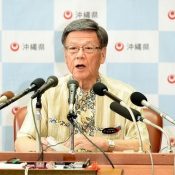
May 26, 2017 Ryukyu Shimpo online edition
At a press conference on May 26 Governor Takeshi Onaga commented on a recent public opinion poll that took place after the Supreme Court of Japan handed down the decision against Okinawa concerning the revocation of landfill reclamation approval. The results of this poll showed that more than 74 percent of Okinawans oppose relocating Marine Corps Air Station Futenma (MCAS Futenma) to Henoko, Nago City. Onaga said, “The poll makes apparent that Okinawans don’t agree with the situation in which Okinawa is being placed, and think that it is absurd and outrageous.”
In addition, Onaga responded to Commandant of the U.S. Marine Corps General Robert Neller’s announcement to Congress that the plan to relocate the U.S. Marines stationed in Okinawa to Guam may be reviewed. Onaga thinks this is due to the influence of missile development in North Korea, but pressed the U.S. to reconsider by saying that he fails to see the wisdom of pushing forward hastily with Henoko base construction while Guam relocation is still under consideration.
As one month has passed since embankment work for the base in Henoko began, Onaga criticized the Japanese government for forcing construction through. He said that the Japanese government is trying to create a fait accompli with no concern for appearances.
Onaga also spoke about the lawsuit he is considering, which would be aimed at stopping construction as a response to unauthorized coral fracturing by the Japanese government. He intends to monitor Japan’s behavior and approach to the coral fracturing hereafter in order to decide whether to request approval to pursue the lawsuit from the prefectural assembly in June.
Regarding his predecessor’s land reclamation permit, Onaga said that he is certain an opportunity to revoke it will emerge, and that from a legal standpoint it is essential that he carefully appraise his timing. He merely stated that he wants to make a decision from a big-picture perspective so that Okinawans can draw closer to their goal.
(English translation by T&CT and Erin Jones)
Go to Japanese
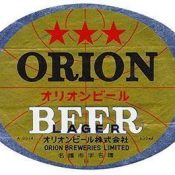
May 17, 2017 Ryukyu Shimpo
Orion Breweries, Ltd (Urasoe, Okinawa; Yoshio Kadekaru, President), widely known as Okinawa’s hometown beer, reached the 60th anniversary of its founding on May 18. 12 years after the conclusion of the Battle of Okinawa, at a time when the industrial infrastructure destroyed in the war had not been fully rebuilt, Okinawa was separated from the Japanese mainland and under American rule, and the economy was largely dependent on imports, a beer maker with a single factory only in Okinawa was born. As the representative company of local manufacturing, Orion Breweries navigated the rough seas of competition and paved the way for exporting Okinawan goods and brands abroad for the global market. This article will take a look at the 60-year history of the “three stars.”
Troubles with market development, and human wave tactics at Sakurazaka
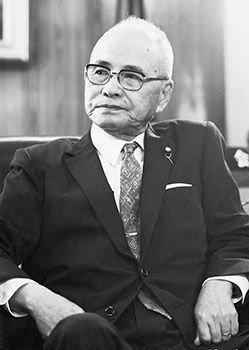
Orion Breweries Founder Sosei Gushiken
On May 18, 1957, Okinwaw Breweries, Ltd. was founded by Sosei Gushiken, known as one of the kings of Okinawan manufacturing. Gushiken also founded Gushiken Miso Shoyu Joint Corporation (now Aka Marusou), Ryukyu Shiryo (a livestock feed company), leading the revitalization of Okinawan manufacturing. However, plagued with the massive investment required by brewing and with the heat and water quality in Okinawa’s tropical climate, it was said that the company was “dead on arrival.”
Gushiken, looking for the highest-quality water, settled on building his factory in Nago. With help from Shigeharu Sakaguchi, who had worked as plan manager for Kirin Beer, and Takeharu Sawada, two authorities on beer brewing, serving as executive plant managers, Gushiken established himself as a top brewer in Okinawa.
To name the new beer, the company asked Okinawan residents for suggestions, and chose “Orion” from around 2,500 submissions. Two years after the founding of the company, on May 17th 1959, the bottled beer came to market across this island. The company then changed its name to Orion Breweries to match the beer and, “be universally effective worldwide.”
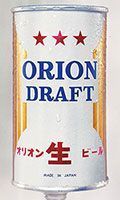
The steel can draft beer released in 1973 to compete with mainland brewers after the Okinawa Reversion
However, at the outset the sale of the beer faced difficulties. “The first year we sold 797 kiloliters, which in today’s numbers is around only three days’ worth of production. At the time, American beer was #1 and Yamato Beer #2. The Okinawan product was called, “island swill” and treated like a second-rate product,” said Kadekeru.
Import regulations on the mainstay imported beer was being ignored by the American civilian leadership. This of course created a quagmire dire enough for Gushiken to consider giving up, however his “never-say-die” spirit kept him going. While it seemed as if Orion Beer had its back against the wall, it was at this time that the “human wave tactic” was deployed with Naha’s Sakurazaka social district as the stage. The entirety of the company’s employees mobilized to the street’s cabarets and restaurants, and by going door-to-door with carts they developed their market by selling beer directly to stores during the day, and observing the pub-crawling customers and the goods being offered during the evening.
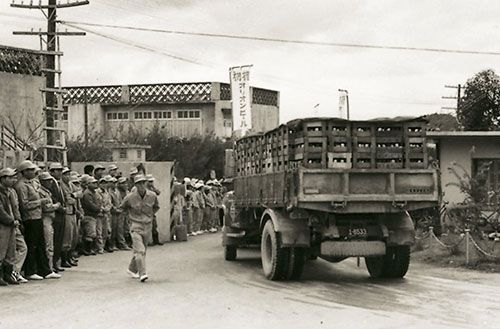
Employees lining up to see off the first shipment of Orion Beer. May 16, 1959
“Whoever controls Sakurazaka, controls Naha. Whoever controls Naha, controls Okinawa.” Just as Gushiken described, soon after this mass mobilization Orion saw a steep incline in support. In 1963, the 6th anniversary discount also paid off, and Orion accounted for 83% of beer consumed in Okinawa, selling 9,000 kiloliters and securing its popularization.
Diversification in the face of increased competition, and the continuing debate over the reduction of the liquor tax
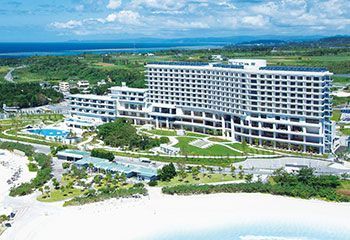
“Hotel Orion Motobu Resort and Spa” which opened in 2014 right next to Ocean Expo Park
Okinawa was brought into the Japanese market with the 1972 reversion of Okinawa to Japan, and for Orion this was the point when competition from the major domestic brewers grew stiffer.
While there was discussions surrounding a merger or acquisition by major brewers, “The company decided on their own strategy to protect local industry” (From Orion Beer, 50 Years of Progress). Along with this, in order to prevent an economic shock occurring due to the reversion, special attention was given to sustaining local industry in the Act on Special Measures for Reversion. There was a measure which reduced the liquor tax for local beer by 60%, giving Orion a price advantage over the major brands.
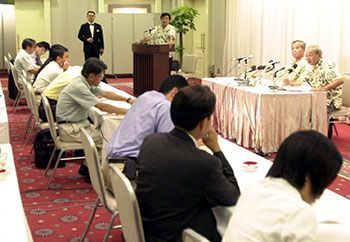
The press conference announcing the details of the partnership between Orion and Ashai Breweries. August 21, 2002 Hotel Seibu Orion in Naha
There was also a large influx of tourists to Okinawa from EXPO Okinawa, and in May, 1974 “Hotel Orion” opened in Motobu, and in June, 1975 “Hotel Seibu Orion” (Currently Hotel Royal Orion) was opened in Nago as a joint investment with Seibu Group. Orion also got involved in agriculture and cultivation, diversifying the business beyond the beverage field.
While this was going on, there were efforts to extend the special measures related to the reversion beyond their five-year expiration, however there was a lot of doubt surrounding the continuation of the “shock alleviation” measures, and Orion needed to come up with a plan anticipating its repeal. In the mid-90’s they battled with the price wars in the domestic beer market due to the emergence of happoshu, a low-malt liquor, and in 2002 Orion was asked to strengthen their management base as a requirement to for the continuation of tax alleviation.
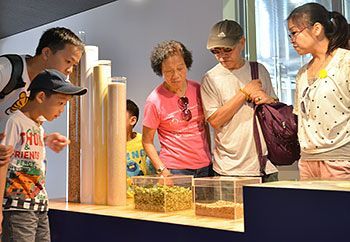
Some of the over 140,000 annual visitors from abroad who come to watch the brewing process at the Beer Park in Nago
In August of the same year, Meiki Kinjo, President of the company at the time, agreed to a comprehensive business partnership with Asahi Breweries. Asahi would acquire 10% of Orion’s stock, and in return “Orion Draft Beer” would be sold nationwide through Asahi’s sales network. Orion would produce Asahi beers such as “Super Dry” at their Nago factory, and sell the beer in Okinawa. Orion would be able to improve their brewing technique as well as the quality of the beer, and enjoy nationwide expansion, while Asahi would get logistical support and a reduction in their tax expenses, making the partnership a mutually beneficial “fifty-fifty” deal.
While the liquor tax alleviation measure was extended for the ninth time in the 2016 year-end tax revision, the period was shortened from five years to two, creating a major blowback. Orion continues to diversify and develop with things such as the opening of a 238-room hotel in Motobu that accommodates up to 900 people named the “Hotel Orion Motobu Resort and Spa.”
Shipping to 16 countries and regions
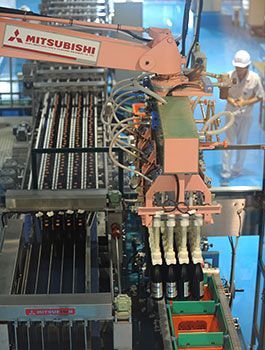
Orion Beer being bottled in the manufacturing line.
As a sign that Orion Beer’s recognition had spread beyond the borders of Japan, in April of last year it received the “Intellectual Property Achievement Awards” Minister of Economy, Trade, and Industry, and the “Excellent Exporting Business” Food Industry Affairs Bureau Chief Award from the Ministry of Agriculture, Forestry, and Fisheries, representing their exceptional efforts in exporting soon after in the same month.
Currently, Orion Beer is exported to 16 countries including the United States, Taiwan, South Korea, Hong Kong, Singapore, Australia, Russia, and Brazil. Exports are boosted by foreigners who visit Okinawa and become regular customers of the beer.
Domestically, the gap between Orion and the top for breweries: Asahi, Kirin, Suntory, and Sapporo remains large; based on the quantity of beer shipped Orion only accounts for about 1% of the total market share. However, according to the 2015 beer export report compiled by the Okinawa Customs House, of the total amount of beer exported from all of Japan (73,770 kiloliters, approx. 8.5 billion yen), Okinawa accounts for 3.4% of the total volume and 4.5% of the revenue, meaning Orion Beer’s brand recognition outpaces its scale.
Over 140,000 people visit Orion Beer Park in Nago each year to watch beer being made from beginning to end, and 70% of these visitors come from other prefectures in Japan or from abroad. Furthermore, around 40% of these visitors come from Taiwan. With 260 Family Mart convenience stores displaying goods in Taiwan, it is Orion’s biggest export destination. According to Orion President Yoshio Kadekaru, “Visitors safely and comfortably watch the brewing process, and then can try the finished product. The Beer Park has made a great contribution.”
(English translation by T&CT and Sam Grieb)
Go to Japanese
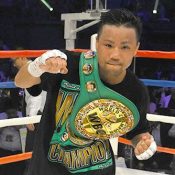
May 23, 2017 Ryukyu Shimpo
Okinawan boxer Daigo Higa of Shira Gushiken Sports Gym recently took the World Boxing Council (WBC) Flyweight title. He has inspired many Okinawans, and the Ryukyu Shimpo sports honor award will be bestowed upon him on June 9. A ceremony will be held that evening at Pacific Hotel Okinawa in Naha for presentation of the award.
This Ryukyu Shimpo sport honor award has been conferred to various Okinawan individuals and teams for their accomplishments in the past. It was awarded in 2010 to the Konan High School Baseball Club for winning Spring-Summer consecutive championships in high school baseball; to golfer Mamiko Higa (now professional) in 2012 for winning two consecutive Japan Women’s Amateur Golf Championships; to Konan High School’s handball team in 2014 for winning the Japan Boys’ Handball Triple Crown; and to the Ryukyu Golden Kings in 2016 for winning four professional basketball TKbj-League Championships.
Daigo Higa’s coach, the World Boxing Association (WBA) Light Flyweight Champion from 1976 to 1981 Yoko Gushiken, received a separate Ryukyu Shimpo award in 2016 for his sports-related achievements.
(English translation by T&CT and Erin Jones)
Go to Japanese
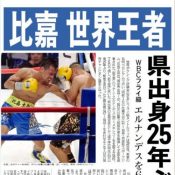
May 20, 2017 Ryukyu Shimpo
Okinawan boxer Daigo Higa, 21, of the Shirai-Gushiken gym and ranked first in the world, captured the WBC Flyweight world title at a match held at the Ariake Coliseum in Tokyo on the evening of May 20. He defeated Mexican Juan Hernandez, 30, with a technical knockout at 2:58 of the sixth round. Hernandez was deprived of the title due to overweight forfeiture at the weigh-in the day before the fight.
Higa is from Urasoe City and Miyako Technical High School in Miyako-jima.
Higa has become the first world champion to hail from Okinawa since Akinobu Hiranaka won WBC Light Welterweight championship 25 years ago. He is the ninth world champion from Okinawa, including Koki Eto who is a former WBA interim Flyweight champion.
Higa extended the undefeated record to 13 wins (13 KOs) and became the first Japanese world champion with a perfect record (all KO victories).
He became the champion at the age of 21, the same age as Yoko Gushiken, 61, president of the gym, who won the WBA Junior Flyweight title in 1976.
Fernandez’s record fell to 37 fights, 34 wins (25 KO) and 3 losses.
(English translation by T&CT)
Go to Japanese
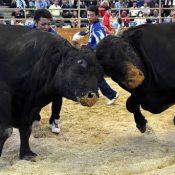
May 15, 2017 Ryukyu Shimpo
The 107th Spring Island-Wide Bullfight was held at the multipurpose dome in Ishikawa, Uruma City on May 14. A total of 24 excellent bulls were selected from the 19 bullfight associations in the prefecture. The bulls waged savage battles and entertained the audience. In the three major title matches, Nakamura Gensui beat the previous champion, Iramina Assou Daishingeki, in the open-weight category to take the title of the strongest bull on the island. In the medium-weight title, in which bulls under 970 kilo grams compete, Hentona Gyu became the new champion, beating the undefeated champion of 13 years Tosho Hayate. In the light-weight title, which is for bulls under 850 kilo grams, Ryushin Ikki successfully retained his title from the last competition. Approximately 4000 people gathered at the venue and enjoyed the heated battles between the strong bulls.
During the match of Shi, the open-weight category of which the winner is determined the strongest bull on the island, the heavist bull Nakamura Gensui beat the previous champion Iramina Assou Daishingeki. The 1050 kilogram bull finished the successful battle within 13 minutes 14 seconds.
From the middle-weight class, a young hope Hentona Gyu bravely challenged Tosho Hayate, winning the tough match after 19 minutes and 26 seconds.
In the light-weight class, an unpredictable battle, Ryushin Ikki managed to defend his previous championship from two years ago.
(English translation by T&CT and Sayaka Sakuma)
Go to Japanese
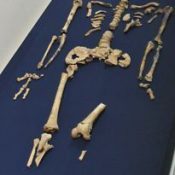
May 20, 2017 Ryukyu Shimpo
On May 19, at the Okinawa Prefectural Buried Cultural Property Center, Nishihara Town, the prefectural education board announced the results of the investigation into the Shiraho Saonetabaru Cave Ruins, which was conducted between fiscal 2012 and 2016.
The cave ruins were confirmed as the first graveyard in the old Paleolithic age in Japan.
At least 19 pieces of full-body human skeletons from the Old Stone Age were found, which is the largest deposit of its kind in the world.
Kamenobu Kinjo, director of the center, emphasized, “It is an important discovery worth a lot to Japanese anthropology and archeology research.”
Among the 19 bodies that were excavated, the human bone tagged No. 4 is from about 27,000 years ago (using calibration age), five thousand years older than the Minatogawa Human Bone.
There were almost full-body skeletons including skulls, and their posture when they were buried became distinguishable.
According to the prefectural education board, it was a funeral similar in style to burial by exposure to the elements, in which remains were placed in a narrow rock-shade on the ground, not in under the ground.”
Regarding the cave ruins previously being judged as a graveyard, the prefectural education board cited the fact that multiple human bones were found in five caves.
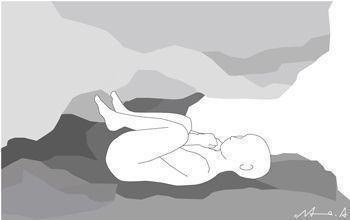
Diagram of burial posture was revealed from “No. 4 Human Bone” (provided by the Prefectural Board of Education)
Chiaki Katagiri, chief expert at the center, said, “There is a high possibility that the place to mourn for the dead and the place for the living were separated, outside and inside the cave respectively.”
However, the prefectural education board officials said it is still to be determined how the ruins will be utilized in the future.
Ishigaki Mayor Yoshitaka Nakayama said, “It is a valuable asset for the island. I think there is a possibility it could be a tourist attraction.”
Ayano Shimabukuro, assistant manager of the municipal board of education and cultural properties section, said, “We want citizens to be able to get close to the valuable ruins.” However, she indicated that there is a problem concerning safety because the ruins are located within the airport.
Glossary: Paleolithic age and calibration age
The Neolithic era, during the period when stones were used as the main tools, about 16,000 years ago, is equivalent to the Jomon period in Japan and the Kaizuka period in Okinawa.
The dating of the Paleolithic Age has been carried out using the radioactive carbon method, but in recent years, the calibration age verified by the annual rings of plants has also been used to determine the date.
The calibration age is about 4,000 years older than the radioactive carbon age, and is closer to the real age.
(English translation by T&CT)
Go to Japanese
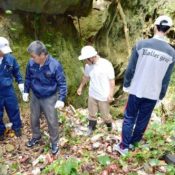
May 13, 2017 Ryukyu Shimpo
On May 12, about 20 people including prefectural officials and Itoman City officials visited and confirmed a site of illegal waste dumping. Illegally dumped waste such as empty cans and household appliances have been piled up for many years under cliffs facing the coast of the National Cemetery for the War Dead during the Battle of Okinawa in Mabuni, Itoman City. Until now, volunteer groups and the city have been conducting clean-up activities, but from now own, the prefecture will discuss with relevant departments and organizations about projects that the prefecture could undertake towards the removal of garbage.
The prefectural environmental improvement division said, “Although we cannot remove all (the waste) immediately, we will think about what we can do as a prefecture.”
A person in charge at the Itoman City Agricultural Policy Division, which owns the illegal dumping site, or “preserved forest area”, said, “We must think about doing garbage removal before bone collection work, which is concerning. It is difficult for the city and the private sector to take care of the issue due to budget problems. I would like to seek the cooperation of the prefecture and the country as part of a postwar process.
The site of illegal dumping spreads about 500 meters below the cliff behind the National Cemetery of War Dead from the Battle of Okinawa.
(English translation by T&CT and Megumi Chibana)
Go to Japanese
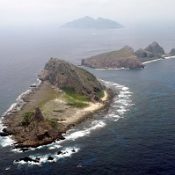
May 12, 2017 Ryukyu Shimpo
On May 12, the government published a research report for 2016 on Okinawa Prefecture’s Senkaku Islands and Shimane Prefecture’s Takeshima. The report included document(s) stating that Ryukyu royalty arrived on the shores of the Senkaku Islands in 1819. This is 26 years earlier than previously thought, according to the oldest disembarkation records by the English from 1845.
The government recognizes the document(s) as clearly reaffirming that the Senkaku Islands are, historically and by international law, a territory inherent to Japan. Jun Matsumoto, Minister in charge of Ocean Policy and Territorial Issues, made a comment during a press conference on May 12. He said, “Presenting objective evidence domestically and internationally is the Japanese way. (We) will continue to conduct (more) research.”
The disembarkation record(s) included in the report were found in the “Family Tree: Genealogy of Ryukyu” contained in the “History of Naha City” owned by the Okinawa Prefectural Library. The record(s) describes how Ryukyu royalty had drifted ashore on an island named Yukunkubajima Island in 1819 and subsequently searched for spring water. This island is believed to be a part of the Senkaku Islands.
The Meiji government integrated the Senkaku Islands in 1895. Now,having disembarkation record(s) listing a date more than 70 years before then, the Cabinet Secretariat said, “This goes to show that even before (the Senkaku Islands) were integrated, Japan had an ongoing relationship with the Senkaku Islands.”
The government researched Japan’s territorial rights over the islands via documents and literature owned by libraries and archives. Every year since 2015, the government has been publishing reports incorporating documents deemed to be vital. This time around, the government researched about 330 documents related to the Senkaku Islands and about 340 documents related to Takeshima.
(Original article by Nozomi Takeuchi of Mainichi Shimbun)
(English translation by T&CT and Chelsea Ashimine)
Go to Japanese
May 19, 2017 Ryukyu Shimpo
(Tokyo) At the House of Councilors Committee on Foreign Affairs and Defense meeting on May 18, Bureau of Defense Buildup Planning director Keiichi Takahashi indicated the possibility that as part of the planned deployment of Ground Self-Defense Forces (GSDF) to Miyakojima City, the missile unit planned to be deployed might station missile launchers and the like on civilian land. He did not clarify whether exercises would be performed outside of GSDF facilities on the island. He also avoided referring to the possibility that SDF ships might dock at civilian ports to supply goods and the like. His comments were in response to a question by Diet member Yoichi Iha of the faction Okinawa Whirlwind.
In response to the North Korea missile issue in February 2016, PAC-3 surface-to-air guided missiles were deployed to civilian land outside SDF facilities in Miyakojima City and Ishigaki City. Thus, Iha asked whether the missile unit to be deployed to Miyakojima would also extend their activities outside of SDF facilities.
Takahashi stated that during a contingency the launching locations for surface-to-ship missiles (SSM) and surface-to-air missiles (SAM) are generally not specified, and further stated that launchers might be deployed outside of SDF facilities, saying, “We do not eliminate the possibility of stationing units off-base in accordance with need.”
Iha also asked whether SDF ships might utilize Hirara Port in order to supply goods and the like. The Ministry of Defense avoided giving an explicit response, merely stating, “We cannot say for certain.” However, it did indicate the possibility that facility units for digging tunnels to hide SDF equipment and the like might be dispatched from Kyushu or elsewhere.
(English translation by T&CT and Sandi Aritza)
Go to Jaoanese
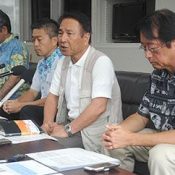
May 16, 2017 Ryukyu Shimpo online edition
On May 16 the All Okinawa Council for Human Rights (which has previously been referred to as the Okinawa International Human Rights Study Group), jointly chaired by Jun Shimabukuro and Eiichi Hoshino, made an announcement at a press conference with Okinawa Peace Movement Center Chairman Hiroji Yamashiro at the Prefectural Government Office. The announcement revealed that in mid-June the Council and Yamashiro will visit the UN Human Rights Council in Geneva, Switzerland, where Yamashiro is prepared to deliver a speech. Yamashiro will start by addressing his arrest while protesting US military facility construction in Takae, Higashi Village, and his 5-month detention following his arrest. From there he will draw attention to how freedom of expression is being infringed in Okinawa.
At the press conference, Yamashiro rhetorically asked if international standards really permit the word of the law to be used for restricting forms of expression such as protest. He assured that, “The international community is taking notice of how democracy is being inhibited in Japan.” In addition, he voiced his desire to bring attention to the fact that things that should not be taking place under international law are occurring in Okinawa.
UN Special Rapporteur David Kaye, who came to Japan in April last year to investigate freedom of expression there, will deliver a report concerning Japan at the UN Human Rights Council in June as well. The report from All Okinawa Council for Human Rights, the speech by Yamashiro, and the report from Kaye will all be parts of a symposium on the status of human rights in Okinawa.
The All Okinawa Council on Human Rights is accepting donations to cover the costs and travel expenses related to this symposium. Contributions can be made online at the following URL: https://japangiving.jp/campaigns/5192
This symposium will require 500,000 yen altogether, and contributors can earn certain gifts for their donations. Giving 5,000 yen earns a message of appreciation and a copy of the written report, 10,000 yen earns the contributor’s name published on the All Okinawa Council for Human Rights blog, and contributors of 30,000 yen will be invited to an information session and lecture session hosted by the Council.
(English translation by T&CT and Erin Jones)
Go to Japanese

















 Webcam(Kokusai Street)
Webcam(Kokusai Street)


